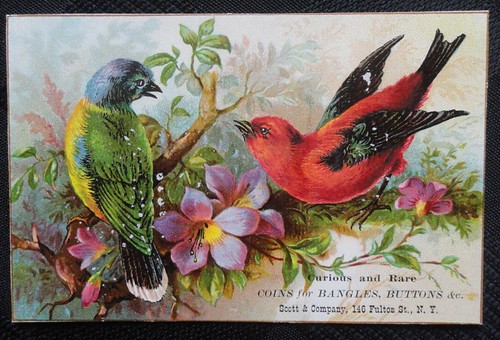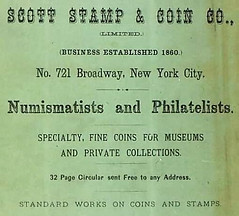
PREV ARTICLE
NEXT ARTICLE
FULL ISSUE
PREV FULL ISSUE
BANGLES: SELLING COINS FOR MAKING LOVE TOKENSCarol Bastable is the President and webmaster of the Love Token Society and also writes for the society's newsletter, the Love Letter. With permission we're publishing
this excerpt of her latest article on where people got some of the coins used to make love tokens. Thanks for submitting this! -Editor
 So is this where it stops? Did anything else influence the selection of the host coin? In respect to brooches, sizes can vary from a half dime up to a Morgan dollar or a large ten or twenty dollar gold piece. I have even seen a Bryan dollar love token made into a brooch. It is hard to say if that was not politically motivated or if such a large pin was ever truly in fashion. Maybe it was one person trying to outdo or outsize an acquaintance as if in competition with the other. Gold was certainly a status item if one wanted to brag about what one had or what one could afford. Surprisingly the host coin selection does not stop here because I recently uncovered a rather interesting piece of ephemera which ties to the subject. Let’s say that a person in 1888 wanted to mark a point in time long ago, long before love tokens were even being made here in the U.S. No coin had been saved from the time period but now looking back on an event like a birth or wedding, someone got an idea that they wanted a love token to mark the date. So what to do? What would today’s person do in the same situation? Well, they would go to a local coin dealer or a coin show and even nowadays EBay is a prime source for locating almost anything. Back then there were fewer coin dealers but it could be done if one lived in a large city or were on a dealer’s mailing list. In my hunt for all things love token related and a desire to unearth additional tangible history, I uncovered a coin dealer’s “trade card” advertisement. Printed on the front of the card is a pair of colorful birds. The design may or may not be coincidental as birds were one of the most popular subjects for love token pictorials. Printed on the lower right of the card is, “Curious and Rare COINS for BANGLES, BUTTONS & c. Scott & Company 146 Fulton St., N.Y.” Last year some Victorian catalog ads were printed in the Love Letter and they referenced the term “bangle”. A bangle is another word for a charm and the term was predominantly used during the Victorian period. So here we have an actual coin dealer who is seeking out another potential market outside of numismatic collectors.
The Scott name is like a fine pedigree and it is very exciting that it has some remote ties to numismatics and Victorian coin jewelry as the trade card shows. The Scott & Company marketing pursuits have left us with some interesting ephemera and a window into why some scarcer coin types were made into love tokens and jewelry. Neat connection. Carol also introduces her readers to the history of the Scott company and its periodical, the The Coin Collector’s Journal. -Editor
For more information on the Love Token Society, see:
For more information on the Scott companies, see:
Wayne Homren, Editor The Numismatic Bibliomania Society is a non-profit organization promoting numismatic literature. See our web site at coinbooks.org. To submit items for publication in The E-Sylum, write to the Editor at this address: whomren@gmail.com To subscribe go to: https://my.binhost.com/lists/listinfo/esylum All Rights Reserved. NBS Home Page Contact the NBS webmaster 
|
